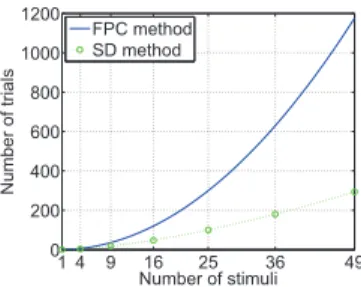SUBJECTIVE ASSESSMENT METHODOLOGY FOR PREFERENCE OF EXPERIENCE IN 3DTV
Texte intégral
Figure


Documents relatifs
Two approaches of literature are here considered for performing the sensitivity analysis of the passive system performance by SS: the first one is local and
214 students, as the most significant subject of didactic system according to ex- perts’ definition, were asked to rate on a 10-point scale the importance of the three subjects of
8, 9, 10 and 11 show the DC conductivity, the structure factor and the double occupancy curves for different values of the staggered potential ∆ at kT = 0.01.. For ∆ & 1 the
Data Assimilation with CPF: In the previous calibration step, all of the three filtering methods are applied to the LNAS model which allow us to esti- mate jointly the
Table 3-7 Comparison of Standard Deviations- Propeller Open Water Table 3-8 Example of predicted power with varied resistance test data Table 3 -9 Comparison of
Maximum likelihood inference Since the latent class structure is a mixture model, the EM algorithm (Dempster et al. 1977, McLachlan and Krishnan 1997) is a privileged tool to derive
To assess the distribution of NPV at the fixed horizon time by the AQMC method, we simulate N copies of the Markov chain in parallel for each strategy, defined in (2) and we reorder
The value of the ratios of spin energy and specific heat computed for 1 ↑ +0 ↓ and 18 ↑ +18 ↓ indi- cate that the sign problem is correctly got round in our simulations..